From clay to bronze, and back again — works by Hanneke van den Bergh
October 26th, 2006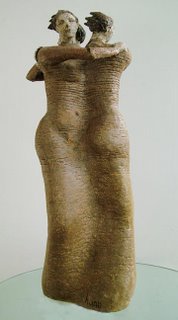 Posted by Karl Zipser
Posted by Karl Zipser
Accidents Happen
Hanneke van den Bergh‘s husband dropped this ceramic sculpture and it shattered on the sidewalk. Her 50 cm high wood-fired piece was a central work for the exhibition to be installed that day . . .
A year later Hanneke was still wondering what to do with the broken sculpture. She had reassembled and glued it together, but did not contemplate selling it. In the meantime, she had been experimenting with bronze casting on a small scale. Using this knowledge of casting, Hanneke decided to try to give new life to the damaged clay sculpture.
The lost wax method
Transforming the clay form to bronze requires an intermediate step, creating a wax replica of the sculpture. Hanneke made this wax form by making a rubber cast of the ceramic sculpture, embedded in a plaster cast. Into the empty cast she poured melted wax to make a hollow wax impression of the clay form.
When the wax version of the sculpture was ready, it gave Hanneke the opportunity to make new creative input. She modified the wax form, adding more interesting hair to the figures in wax, for example. The sculpture now combined the properties of both clay and wax forms.
To cast the bronze, the wax is embedded in a plaster and gravel column. The hollow interior is also filled with the plaster and gravel; Conduits for the bronze to flow in, and the air to flow out, are made. Then the plaster-gravel-wax mass is heated in a kiln, causing the wax to flow out and sublimate, leaving an empty shell of air where the bronze is to come. This is why this is called the “lost wax” method — the wax model is destroyed in the process.
Bronze is heated to 1200 centigrade in a crucible. The molten bronze, with a consistency like cream, is poured into the mold. The pouring of the glowing, liquid metal is a spectacular sight. The sound is also surprising, the sound of a tall glass being filled with water from a pitcher.
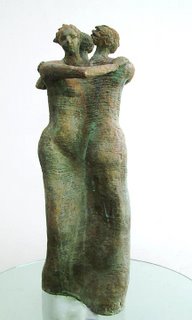 When cool, the bronze sculpture is freed from the plaster and gravel, cleaned of excess metal, and given a patina, in this case green. The result is a new version of the original sculpture with an entirely different aesthetic effect (click images to enlarge.)
When cool, the bronze sculpture is freed from the plaster and gravel, cleaned of excess metal, and given a patina, in this case green. The result is a new version of the original sculpture with an entirely different aesthetic effect (click images to enlarge.)
The bronze version of the above sculpture can be dropped on the sidewalk without breaking. In fact, its structure does not even test the limits of what bronze can do. With metal as her production medium, Hanneke began to sculpt in clay in a different way, making figures such as this woman (which would yield a fragile form as a fired ceramic piece.) 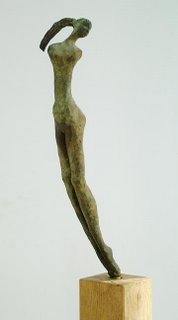 In bronze, this figure, based on a clay original, is stable even in this highly unbalanced mounting. Thus, the experience of working with bronze can influence the way Hanneke works in clay. Her work takes advantages of the best aspects of each medium — the plastic sensuality of the clay, the rigid firmness of the bronze.
In bronze, this figure, based on a clay original, is stable even in this highly unbalanced mounting. Thus, the experience of working with bronze can influence the way Hanneke works in clay. Her work takes advantages of the best aspects of each medium — the plastic sensuality of the clay, the rigid firmness of the bronze.
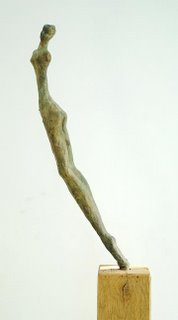 For me a big lesson of my visit with Hanneke van den Bergh was that one should beware of talking with a bronze sculptor — one may find an irresistible urge to try this medium one’s self.
For me a big lesson of my visit with Hanneke van den Bergh was that one should beware of talking with a bronze sculptor — one may find an irresistible urge to try this medium one’s self.
Do you have questions for Hanneke van den Bergh? Ask them here on Art & Perception.
What do you think of the bronze version of the ceramic sculpture? Is it stronger, in the aesthetic sense? Or just different? Should Hanneke van den Bergh stick with clay, or combine the media as she does?
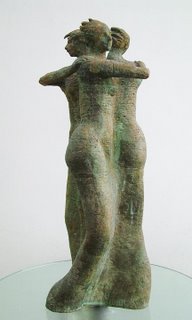
October 26th, 2006 at 5:22 am
Both mediums seem to be used to Hanneke’s advantage. I think the photographs can only hint at the differences. So I would say to continue with both, as each would provide valuable differences. Having said that, I have been in love with metal for a while. The images of Hanneke’s women on her web site are immensely appealing. I would love to see them in person. I would REALLY love to own one.
October 26th, 2006 at 5:42 am
Gramercy Galleria,
I agree with your comments about owning one of Hanneke’s sculptures. In case there is any confusion for other readers, this is not the same Hanneke who painted the still-life posted yesterday. I’d like to own that piece also, but it is sold already.
Photography does not quite do justice to the bronzes. At least, not here. Perhaps it is because of the white background, which gives limited contrast. In real life the bronze sculpture is much stronger. The ceramic sculpture reproduces fairly well.
October 26th, 2006 at 6:48 am
An illustration of the philosophical comment: in every breakdown there is a breakthrough.
October 26th, 2006 at 1:34 pm
Karl,
I actually figured out that there were two Hannekes in your links after some major confusion one day.
I really wanted to comment on the Hanneke’s still life yesterday, but I thought the piece so wonderful that my comment would be boring after the intense discussion preceding.
Sometimes I do want to say “this touches me deeply” or “this is the most beautiful pear (for example) that I’ve ever seen.” I realize that is a far cry from any kind of critique or technical discussion, but I am happy to know that my work touches someone. I guess the debate will go on.
The crucial point here? Viewing art that is beautiful or touching in some way makes me different and I go on to do something, and maybe everything, differently.
October 27th, 2006 at 5:11 am
Hanneke’s sculptures are soooooo amazing soooooo beautiful. I just would love to have one or more for myself in my home, definitely my cup of tea.
October 27th, 2006 at 5:54 am
Angela, good to see you back on A&P. Those of us who want Hanneke van den Bergh’s sculpture now have extra incentive to improve our art sales. These sculptures are not inexpensive!
October 27th, 2006 at 7:58 am
The softness of ceramic is beautiful for sculptures that can be supported by gravity (first picture) and the strength of metal is ideal for sculptures (last picture) that leap into space.
October 27th, 2006 at 1:28 pm
OH my god, I can hardly get past the image of a spouse dropping and breaking an art piece. Fascinating.
I like the metal and ceramic versions fairly equally.
I love the lost wax procedures…
October 27th, 2006 at 3:32 pm
I love the bronze statues. They are much more attractive than the clay statue. They are richer, more substantive, stronger, more expressive, and more textured.
October 29th, 2006 at 4:12 am
i think the bronze came out good
… imho one of the skills of a good artist…is the ability to recover from your mistakes… and not make it look like a mistake anymore…
October 29th, 2006 at 4:39 am
I would make an elaborated critic if I knew anything about sculpting… I just look at it in my computer screen and I like a lot what I see and must probably would buy one if was available to me. So here is my sincere comment.